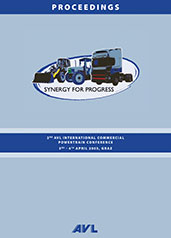Technical Paper
01 CAE analysis of a CVT toothed belt
2002-10-29
2002-32-1770
This work deals with the CAE simulation of the behaviour of a belt employed in a CVT transmission of a large displacement scooter engine. Both FEM and MBS simulations were performed, in order to estimate the dynamic loads acting on the component and the stress state the belt is subject to. The MBS simulations were backed up by simple FEM tests performed in order to estimate the elastic properties of elementary portions of the belt. The MBS system comprised the belt and the two pulleys. As a result, the force components the pulleys exert on the belt were calculated. FEM non-linear analyses were performed in order to estimate the stress state the belt experiences. The belt's both manufacturing and working conditions were simulated.


